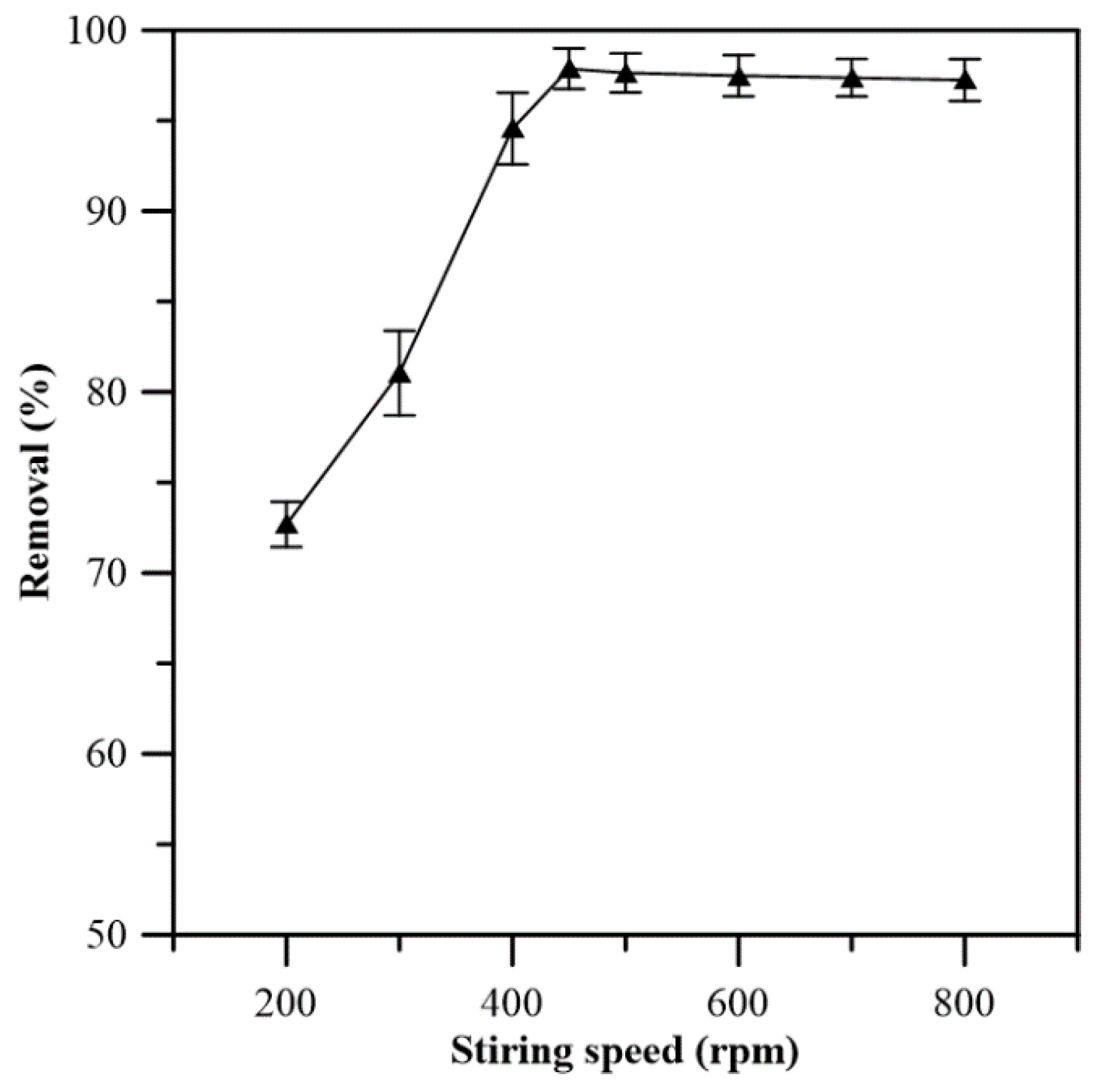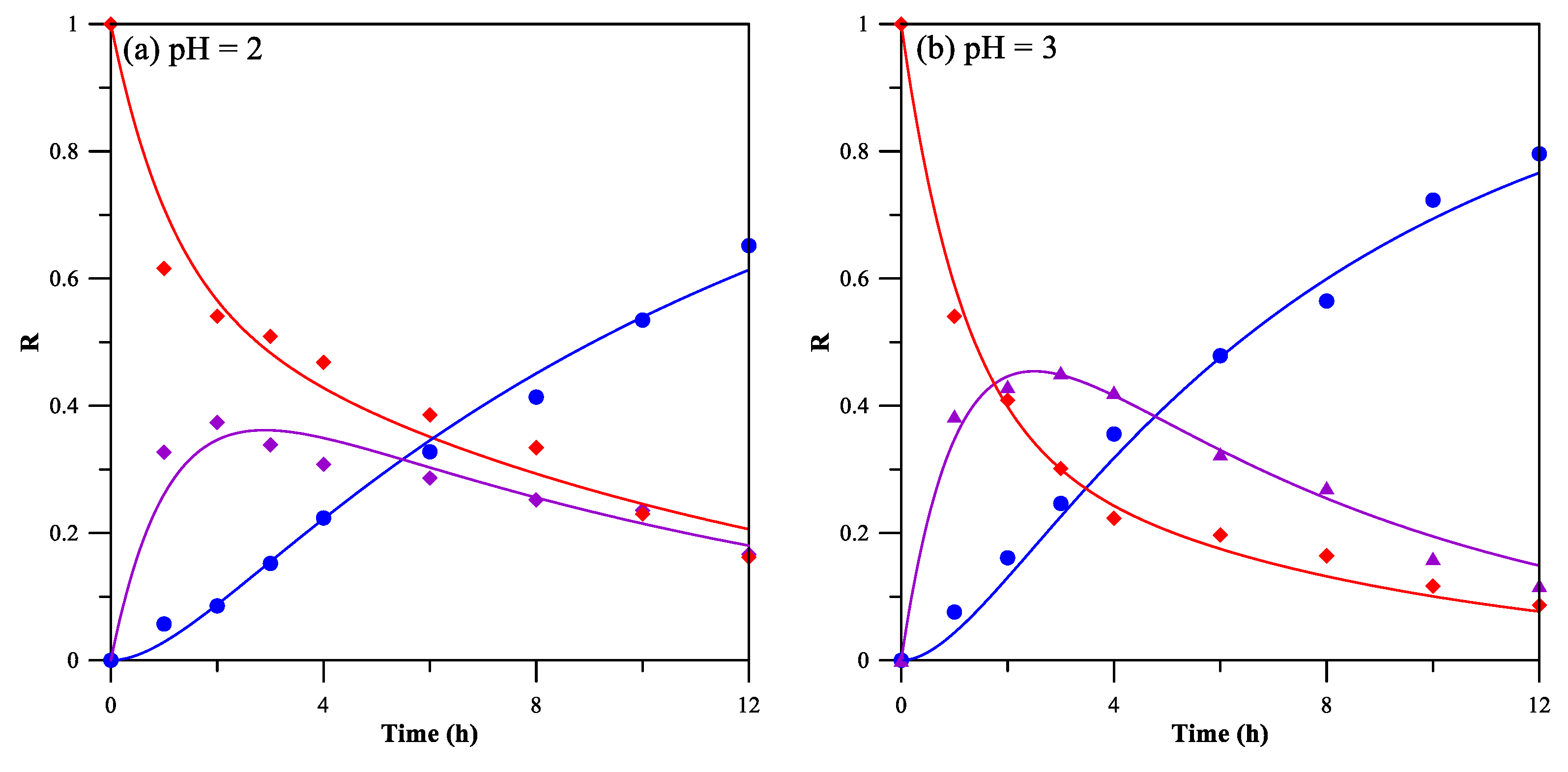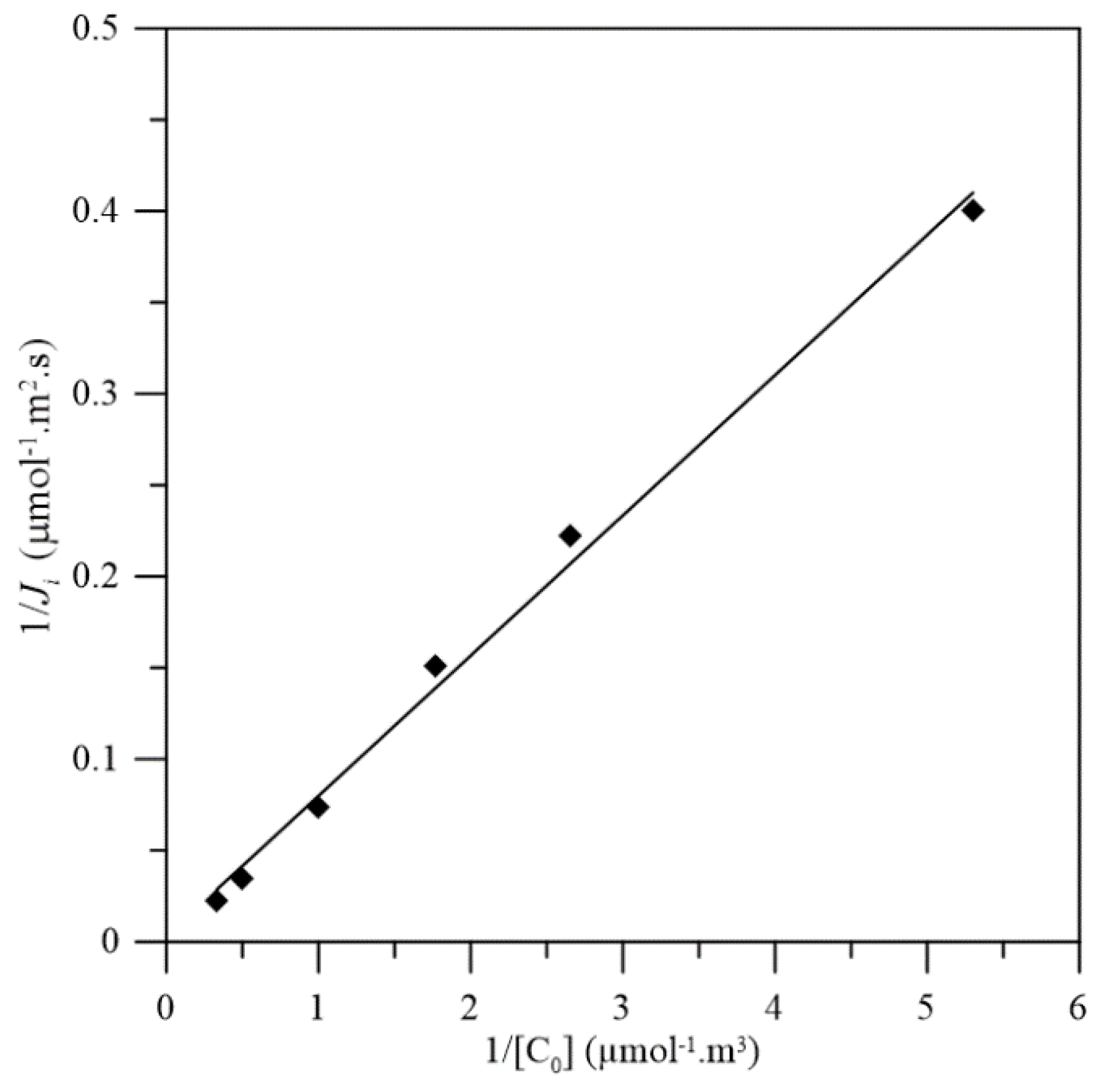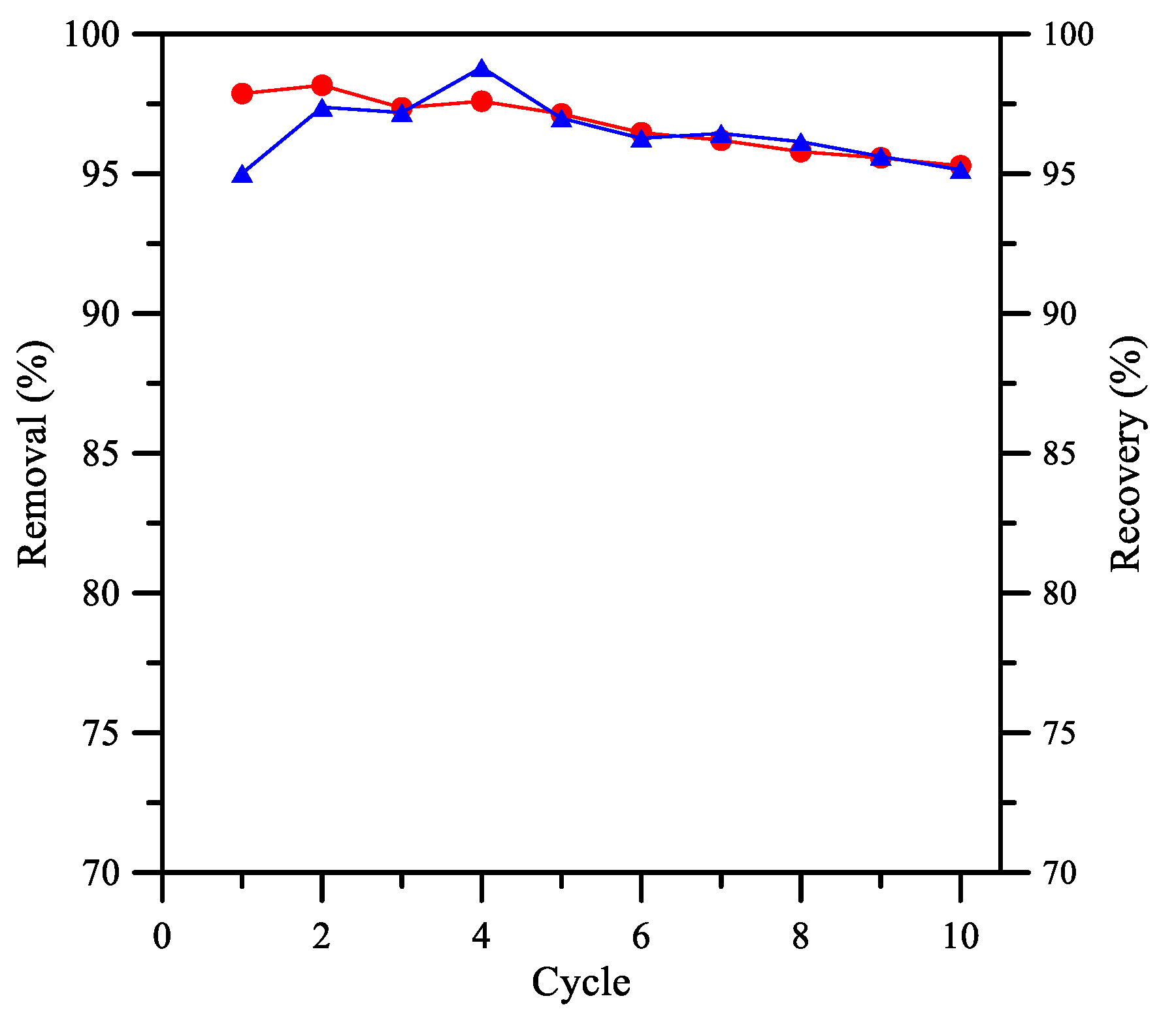Application of PolyHIPE Membrane with Tricaprylmethylammonium Chloride for Cr(VI) Ion Separation: Parameters and Mechanism of Transport Relating to the Pore Structure
Abstract
:1. Introduction
2. Experimental
2.1. Chemicals
2.2. Preparation and Characterization of PolyHIPE Membrane
2.3. Preparation of Aliquat 336/PolyHIPE Membrane
2.4. Cr(VI) Transport Study
3. Results and Discussion
3.1. Chemical and Physical Characteristics of PolyHIPE Membrane
3.2. Pore Structure of PolyHIPE Membrane
3.2.1. Pore Size Distribution
3.2.2. Tortuosity
3.2.3. Constrictivity
3.3. Preparation of Aliquat 336/PolyHIPE Membrane
3.4. Transport Study of Cr(VI) through Aliquat 336/PolyHIPE Membrane
- (1)
- Diffusion of Cr(VI) from feeding phase to the interface.
- (2)
- Formation of Cr(VI)–extractant complex at the feed phase–membrane interface.
- (3)
- Diffusion of Cr(VI)–extractant complex through the membrane.
- (4)
- Dissociation of Cr(VI)–extractant complex at the stripping phase–membrane interface, to release the Cr(VI) into the stripping phase.
- (5)
- Diffusion of the Cr(VI) from the interface to the stripping phase.
3.4.1. Influence of the Stirring Rate
3.4.2. pH Effect on the Transport of Cr(VI) through the Aliquat 336/PolyHIPE Membrane
3.4.3. Modeling and Parameters of Cr(VI) Diffusion
3.4.4. Stability of Aliquat 336/PolyHIPE Membrane
3.5. Separation of Cr(VI) from Mixed Ion Solution
4. Conclusions
Acknowledgments
Author Contributions
Conflicts of Interest
References
- Ochromowcz, K.; Apostoluk, W. Modelling of carrier mediated transport of chromium(III) in the supported liquid membrane system with D2EHPA. Sep. Sci. Technol. 2010, 72, 112–117. [Google Scholar]
- Kocherginsky, N.M. Facilitated transport of alkali metal cations through supported liquid membranes with fatty acids. ACS Symp. Ser. 1996, 642, 75–88. [Google Scholar]
- Parhi, P.K. Supported liquid membrane principle and its practices: A short review. J. Chem. 2013, 1–11. [Google Scholar] [CrossRef]
- Ho, W.S.W.; Sirkar, K.K. Membrane Handbook; Chapman & Hall: New York, NY, USA, 1992. [Google Scholar]
- Zhang, W.; Cui, C.; Hao, Z. Transport study of Cu(II) through hollow fiber supported liquid membrane. Chin. J. Chem. Eng. 2010, 18, 48–54. [Google Scholar] [CrossRef]
- Ren, Z.; Zhang, W.; Meng, H.; Liu, J.; Wang, S. Extraction separation of Cu(II) and Co.(II) from sulfuric solutions by hollow fiber renewal liquid membrane. J. Membr. Sci. 2010, 365, 260–268. [Google Scholar] [CrossRef]
- De Gyves, J.; Rodriguez de san Miguel, E. Metal ion separations by supported liquid membrane. Ind. Eng. Chem. Res. 1999, 38, 2182–2202. [Google Scholar] [CrossRef]
- Alguacil, F.J.; Villegas, M.A. Liquid membranes and the treatment of metal bearing wastewaters. Rev. Metal. Madrid. 2002, 38, 45–55. [Google Scholar] [CrossRef]
- Othman, N.; Harruddin, N.; Idris, A.; Ooi, Z.; Fatiha, N.; Sulaiman, R.N.R. Fabrication of polypropylene membrane via thermally induced phase separation as a support matrix of tridodecylamine supported liquid membrane for Red 3BS dye removal. Desalin. Water Treat. 2016, 57, 12287–12301. [Google Scholar] [CrossRef]
- Neplenbroek, A.M.; Bargeman, D.; Smolders, C.A. Supported liquid membranes: Stabilization by gelation. J. Membr. Sci. 1992, 67, 149–165. [Google Scholar] [CrossRef]
- Kemperman, A.J.B.; Rolevink, H.H.M.; van den Boomgaard, T.; Strathmann, H. Hollowfiber-supported liquid membranes with improved stability for nitrate removal. Sep. Purif. Technol. 1997, 12, 119–134. [Google Scholar] [CrossRef]
- Jabera, A.M.Y.; Alia, S.A.; Yahayab, G.O. Studies on phenol permeation through supported liquid membranes containing functionalized polyorganosiloxanes. J. Membr. Sci. 2005, 250, 85–94. [Google Scholar] [CrossRef]
- Danesi, P.R.; Reichley-Yinger, L. A composite supported liquid membrane for ultraclean Co., Ni separations. J. Membr. Sci. 1986, 27, 339–347. [Google Scholar] [CrossRef]
- Arslana, G.; Tor, A.; Muslua, H.; Ozmena, M.; Akina, I.; Cengeloglua, Y.; Ersoz, M. Facilitated transport of Cr (VI) through a novel activated composite membrane containing Cyanex 923 as a carrier. J. Membr. Sci. 2009, 337, 224–231. [Google Scholar] [CrossRef]
- Chen, J.H.; Le, T.T.M.; Hsu, K.C. Cr(VI) separation by PolyHIPE membrane immobilized with Aliquat 336 by solvent-nonsolvent method. Membr. Water Treat. 2017, 8, 575–590. [Google Scholar]
- Kislik, V.S. Liquid Membranes: Principles and Applications in Chemical Separations and Wastewater Treatment; Elsevier: Oxford, UK, 2009. [Google Scholar]
- Cameron, N.R.; Sherrington, D.C.; Albiston, L.; Gregory, D.P. Study of the formation of the open-cellular morphology of poly(styrene/divinylbenzene) polyHIPE materials by cryo-SEM. Colloid Polym. Sci. 1996, 274, 592–595. [Google Scholar] [CrossRef]
- Tanko, N.L. Transport Relationships in Porous Media as a Model for Oil Reservoir Rocks. Ph.D. Thesis, University of Bath, Bath, UK, 2011. [Google Scholar]
- Adler, P.M. Porous Media: Geometry and Transport; Butterworth-Heinemann: Boston, MA, USA, 1992. [Google Scholar]
- Derrick, M.R.; Stulik, D.; Landry, J.M. Infrared Spectroscopy in Conservation Science: Scientific Tools for Conservation; Getty Conservation Institute: Los Angeles, CA, USA, 1999. [Google Scholar]
- Zhao, C.; Danish, E.; Cameron, N.R.; Kataky, R. Emulsion-templated porous materials (PolyHIPEs) for selective ion and molecular recognition and transport: Applications in electrochemical sensing. J. Mater. Chem. 2007, 23, 2446–2454. [Google Scholar] [CrossRef]
- Melita, L.; Popescu, M. Removal of Cr(VI) from industrial water effluents and surface waters using activated composite membranes. J. Membr. Sci. 2008, 312, 157–162. [Google Scholar] [CrossRef]
- Singare, P.U.; Lokhande, R.S.; Madyal, R.S. Thermal Degradation Studies of Some Strongly Acidic. Open J. Phys. Chem. 2011, 1, 45–54. [Google Scholar] [CrossRef]
- Coq, L.L. Influence on Permeability of the Structural Parameters of Heterogeneous Porous Media. Environ. Technol. 2007, 29, 141–149. [Google Scholar] [CrossRef] [PubMed]
- Wu, Y.S.; Lucas, J.V.; Frijlink, H.W.; Maarschalk, K.M.V. Determination of relative path length as a measure for tortuosity in compacts using image analysis. Eur. J. Pharm. Sci. 2006, 28, 433–440. [Google Scholar] [CrossRef] [PubMed]
- Andrea, L.; Leone, P.; Asinari, P. Microstructural characterization of solid oxide fuel cell electrodes by image analysis technique. J. Power Sources 2009, 194, 408–422. [Google Scholar]
- Lawrence, M.A.; David, R.C. Characterization and Analysis of Porosity and Pore Structures. Rev. Mineral. Geochem. 2015, 80, 61–164. [Google Scholar]
- Lawrence, R.; Jiang, Y. Porosity, pore size distribution, micro-structure. In Bio-Aggregates Based Building Materials; Springer: Dordrecht, The Netherlands, 2017; pp. 39–71. [Google Scholar]
- Shen, L.; Chen, Z. Critical review of the impact of tortuosity on diffusion. Chem. Eng. Sci. 2007, 62, 3748–3755. [Google Scholar] [CrossRef]
- Koponen, A.; Kataja, M.; Timonen, J. Tortuous flow in porous media. Phys. Rev. 1996, 54, 406–410. [Google Scholar] [CrossRef]
- Wiedenmann, D.; Keller, L.; Holzer, L.; Stojadinović, J.; Münch, B.; Suarez, L.; Fumey, B.; Hagendorfer, H.; Brönnimann, R.; Modregger, P.; et al. Three-Dimensional Pore Structure and Ion Conductivity of Porous Ceramic Diaphragms. AIChE J. 2013, 59, 1446–1457. [Google Scholar] [CrossRef]
- Brakel, J.; van Heertjes, P.M. Analysis of diffusion in macroporous media in terms of a porosity, a tortuosity and a constrictivity factor. Int. J. Heat Mass Transfer 1974, 17, 1093–1103. [Google Scholar] [CrossRef]
- Nussinovitch, A.; Peleg, M. An empirical model for describing weight changes in swelling and shrinking gels. Food Hydrocoll. 1990, 4, 69–76. [Google Scholar] [CrossRef]
- Turhana, M.; Sayara, S.; Gunasekaranb, S. Application of Peleg model to study water absorption in chickpea during soaking. J. Food Eng. 2002, 53, 153–159. [Google Scholar] [CrossRef]
- Benjjar, A.; Hor, M.; Riri, M.; Eljaddi, T.; Kamal, O.; Lebrun, L.; Hlaïbi, M. A new supported liquid membrane (SLM) with methyl cholate for facilitated transport of dichromate ions from mineral acids: Parameters and mechanism relating to the transport. J. Mater. Environ. Sci. 2012, 3, 826–839. [Google Scholar]
- Zhang, W.; Liu, J.; Ren, Z.; Wang, S.; Du, C.; Ma, J. Kinetic study of chromium(VI) facilitated transport through a bulk liquid membrane using tri-n-butyl phosphate as carrier. Chem. Eng. J. 2009, 155, 83–89. [Google Scholar] [CrossRef]
- Mehmet, K.; Hamza, K.A.; Ahmet, K.; Nurcan, A.; Ahmet, O.G.; Mustafa, A. A kinetic study of mercury (II) transport through a membrane assisted by new transport reagent. Chem. Cent. J. 2011, 5, 43–49. [Google Scholar]
- Weckhuysen, B.M.; Wachs, I.E.; Schoonheydt, R.A. Surface Chemistry and Spectroscopy of Chromium in Inorganic Oxides. Chem. Rev. 1996, 96, 3327–3349. [Google Scholar] [CrossRef] [PubMed]
- Kaya, A.; Alpoguz, H.K.; Yilmaz, A. Application of Cr(VI) Transport through the Polymer Inclusion Membrane with a New Synthesized Calix[4]arene Derivative”. Ind. Eng. Chem. Res. 2013, 52, 5428–5436. [Google Scholar] [CrossRef]
- Kozlowski, C.A.; Walkowiak, W. Applicability of liquid membranes in chromium(VI) transport with amines as ion carriers. J. Membr. Sci. 2005, 266, 143–150. [Google Scholar] [CrossRef]
- Kebiche-Senhadji, O.; Tingryb, S.; Setab, P.; Benamora, M. Selective extraction of Cr(VI) over metallic species by polymer inclusion membrane (PIM) using anion (Aliquat 336) as carrier. Desalination 2010, 258, 59–65. [Google Scholar] [CrossRef]
- Scindia, Y.M.; Pandey, A.K.; Reddy, A.V.R. Coupled-diffusion transport of Cr(VI) across anion-exchange membranes prepared by physical and chemical immobilization methods. J. Membr. Sci. 2005, 249, 143–152. [Google Scholar] [CrossRef]
- Rodríguez de San Miguel, E.; Vital, X.; Gyves, J. Cr(VI) transport via a supported ionic liquid membrane containing CYPHOS IL101 as carrier: System analysis and optimization through experimental design strategies. J. Hazard. Mater. 2014, 273, 253–262. [Google Scholar] [CrossRef] [PubMed]
- Alguacil, F.J.; Caravaca, C.; Martin, M.I. Transport of chromium(VI) through a Cyanex 921-supported liquid membrane from HCl solutions. J. Chem. Technol. Biotechnol. 2003, 78, 1048–1053. [Google Scholar] [CrossRef]
- Huang, D.; Huang, K.; Chen, S.; Liu, S.; Yu, J. Rapid Reaction Diffusion Model for the Enantio separation of Phenylalanine across Hollow Fiber Supported Liquid Membrane. Sep. Sci. Technol. 2008, 2, 259–272. [Google Scholar] [CrossRef]
- Velicky, M.; Tam, K.Y.; Dryfe, R.A.W. Mechanism of Ion Transfer in Supported Liquid Membrane Systems: Electrochemical Control over Membrane Distribution. Anal. Chem. 2014, 86, 435–442. [Google Scholar] [CrossRef] [PubMed]
- Rhlalou, T.; Ferhat, M.; Frouji, M.A.; Langevin, D.; Métayer, M.; Verchère, J.F. Facilitated transport of sugars by a resorcinarene through a supported liquid membrane. J. Membr. Sci. 2000, 168, 63–73. [Google Scholar] [CrossRef]
- Rajewski, J.; Łobodzin, P. An experimental analysis of the transport mechanism of chromium(III) ions in the polymer inclusion membrane system stract. Probl. Eksploat. 2016, 1, 105–117. [Google Scholar]
- Xu, J.; Paimin, R.; Shen, W.; Wang, X. An Investigation of Solubility of Aliquat 336 in Different Extracted Solutions. Fiber. Polym. 2003, 4, 27–31. [Google Scholar] [CrossRef]
- Mulder, M. Basic Principles of Membrane Technology; Kluer Academic Publishers: Dordrecht, The Netherlands; Boston, MA, USA; London, UK, 1991. [Google Scholar]









| St:EHA:DVB a | Visual Physical Quality | Shore Hardness LX-C | Porosity (%) | Specific Volume (cm3/g) |
|---|---|---|---|---|
| 90:0:10 | hard, brittle | 85.0 ± 2.5 | 0.68 ± 0.02 | 3.22 ± 0.28 |
| 60:30:10 | hard, brittle | 65.1 ± 3.4 | 0.71 ± 0.01 | 3.70 ± 0.57 |
| 30:60:10 | flexible, strong | 52.6 ± 4.5 | 0.77 ± 0.03 | 4.35 ± 0.35 |
| 0:90:10 | elastomeric, sticky | 32.5 ± 6.2 | 0.78 ± 0.01 | 4.76 ± 0.59 |
| pH | k1 (×10−6 m/s) | k2 (×10−6 m/s) | R2 | Jf0 (µmol/m2 s) | ||
|---|---|---|---|---|---|---|
| Feeding | Membrane | Stripping | ||||
| 2 | 8.33 | 3.96 | 0.99 | 0.95 | 0.99 | 8.54 |
| 3 | 12.11 | 4.38 | 0.99 | 0.98 | 0.99 | 12.13 |
| 4 | 13.54 | 9.58 | 0.98 | 0.96 | 0.99 | 14.38 |
| 5 | 14.58 | 9.79 | 0.97 | 0.98 | 0.99 | 14.52 |
| [Cr(VI)]o | Feeding Phase | Membrane Type/Base Polymer | Carrier | Jf0 | Membrane Thickness | Ref. |
|---|---|---|---|---|---|---|
| (mol/L) | pH | (µmol/m2 s) | (µm) | |||
| 2.0 × 10−4 | 0.12 | PIM/CTA | Calix[4]arene | 2.253 | 42 | [39] |
| 2.0 × 10−3 | 1 | PIM/CTA | Aliquat 336 | 8.84 | 28 | [40] |
| 2.3 × 10−4 | 1.2 | PIM/CTA | Aliquat 336 | 3.11 | 80 | [41] |
| 1.8 × 10−6 | 8 | PIM/CTA | Aliquat 336 | 0.002 | 62 | [42] |
| 1.0 × 10−3 | 1 | ACM | Cyanex 923 | 10.91 | 90 | [14] |
| 1.0 × 10−3 | 1 | ACM | Cyanex 923 | 11.94 | 25 | |
| 3 × 10−4 | 2 | SLM | CYPHOS IL101 | 5.5 | 125 | [43] |
| 7.5 × 10−4 | 0 | SLM | Cyanex 921 | 6.7 | 125 | [44] |
| 1.0 × 10−3 | 4 | SLM/PolyHIPE | Aliquat 336 | 14.38 | 120 | this study |
| Ion Matter | Recovery (%) | Separation Factor (a) |
|---|---|---|
| Cr(VI) | 95.09 | 1 |
| Cation | ||
| Ni(II) | 1.23 | 77.07 |
| Mg(II) | 0.78 | 120.60 |
| Cu(II) | 1.61 | 86.75 |
| Anion | ||
| SO42− | 3.49 | 27.19 |
| F− | 8.51 | 11.17 |
© 2018 by the authors. Licensee MDPI, Basel, Switzerland. This article is an open access article distributed under the terms and conditions of the Creative Commons Attribution (CC BY) license (http://creativecommons.org/licenses/by/4.0/).
Share and Cite
Chen, J.-H.; Le, T.T.M.; Hsu, K.-C. Application of PolyHIPE Membrane with Tricaprylmethylammonium Chloride for Cr(VI) Ion Separation: Parameters and Mechanism of Transport Relating to the Pore Structure. Membranes 2018, 8, 11. https://doi.org/10.3390/membranes8010011
Chen J-H, Le TTM, Hsu K-C. Application of PolyHIPE Membrane with Tricaprylmethylammonium Chloride for Cr(VI) Ion Separation: Parameters and Mechanism of Transport Relating to the Pore Structure. Membranes. 2018; 8(1):11. https://doi.org/10.3390/membranes8010011
Chicago/Turabian StyleChen, Jyh-Herng, Thi Tuyet Mai Le, and Kai-Chung Hsu. 2018. "Application of PolyHIPE Membrane with Tricaprylmethylammonium Chloride for Cr(VI) Ion Separation: Parameters and Mechanism of Transport Relating to the Pore Structure" Membranes 8, no. 1: 11. https://doi.org/10.3390/membranes8010011




